BUSHBURY IN THE
TWENTIETH CENTURY
Before the Great War
When the new century opened most of the population at the western end of
Bushbury earned their living either from employment by the railway companies
or the Electric Construction Company, and the centre of life in the parish
was established at the junction of Bushbury Lane and Stafford Road. A
service of trams from here into Wolverhampton was started in 1905, and by
1912 the railway passenger service from Bushbury was little used and the
station was closed. In 1902 at the Wolverhampton Art and Industrial
Exhibition, held in the West Park the Electrical Construction Company was
one of the principal contributors.
|
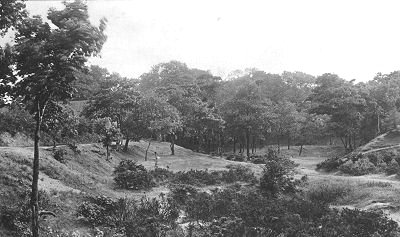
Looking south, in the 1930s. |
Bushbury Hill was very different from today. The
hollow in the centre of this picture, and the deep quarry out of
sight to the right, were both filled in during the 1940s and 50s.
The roof of the outbuildings of Bushbury Farm can just be seen in
the trees on the left. |
| In July 1907 there was a further expansion of railway activity in the
parish when the Great Western company opened their new sheds at Oxley, at
the western end of the Gorsebrook viaduct at the extreme south of the parish
in the area, known as Saltmore in earlier times.
This installation was
considerably larger than the LNW shed at Bushbury and there was an influx of
men from other parts of the GW system, as far away as Devon and South Wales. |
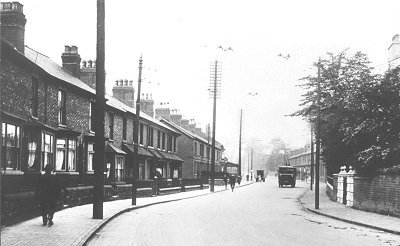
Entering the parish at Stafford Road, Gorsebrook, about 1930.
|
The Great War
|

Wobaston Lane, Fordhouses, in the 1930s.
|
The effect of the Great War on the parish can best be illustrated by the
War Memorial in the Parish Church, although it seems unlikely that the names
listed there are the total number of men from the parish who died.
Reminders
of life on the Western Front, if they were needed, were the ambulance trains
bringing wounded men from France, which were routed from the GW system at
Cannock Road up onto the Grand Junction line, and so to hospitals in
the north of England, over the same route as that used by Queen
Victoria in the 1860s. |
| Another reminder was the training of young horses for pulling
gun limbers on the slopes of Bushbury Hill, a far cry from the
Phillips family and their race horses in the previous century. |
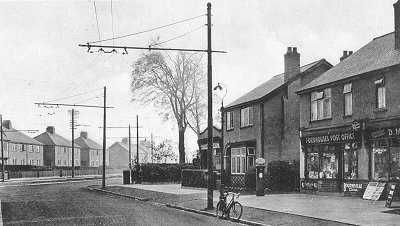
This view of Fordhouses was taken from Wobaston Lane about
1937. |
New factories, new employment
Soon before the war started another factory had been established at Oxley
on the Stafford Road. Messrs. Macfarlane and Robinson built a plant for the
production of enamel hollowware, which was used during the war for shell
inspection, but it did not survive the early post-war depression and closed
in 1926. The premises were bought by the Goodyear Tyre and Rubber Company in
1927, an enterprise which continued to expand until it employed 1700 people
in 1939.

Bushbury Hill in the 1920s, the
path over the hill from the end of Old Fallings Lane. Bushbury Hill
farm was on the right of the picture. |
Near the eastern end of the parish, the sinking of the new Hilton Main
Colliery in Shareshill parish, which started in December 1919, provided work
for many Essington men, and by the time the Holly Bank Colliery closed in
1927, most of its employees found work at Hilton Main, which survived with a
change of ownership in 1932, to be nationalised after the Second World War
and finally closed only in 1969. |
| This building does not appear on
the 1845 tithe map. It stood on the west side of Stafford Road
between Wobaston Lane and Coven Heath.
It was
demolished in the 1930s when the road was converted to a dual
carriageway. |
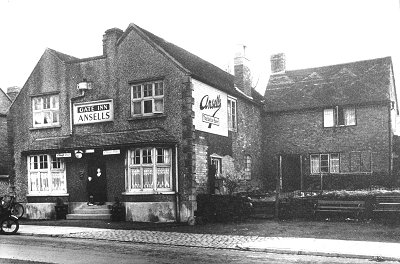
The Gate Inn, Fordhouses.
|
Also in the nineteen twenties, two motor manufacturing companies built
plants in the parish. In 1922 the Star Engineering Co. of Frederick Street
Wolverhampton bought 22 acres of land in Showell Road. For the first few
years bodies only were built here but, following the acquisition of the
business by Sidney Guy in 1928, plans were made to transfer all production
to Bushbury.
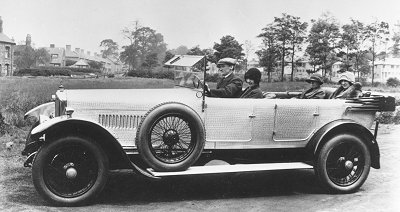
A 1926 Star 20/50 Open Tourer, photographed in
the field behind the company's Showell Road works (now a recreation
field). |
Two luxury models of 18 and 21 horsepower were
produced, the Comet and Planet respectively, followed by a smaller
14 H.P. Comet. But by
1932 the worst effects of the general trade depression were felt and the
company was forced to close.
The factory stood idle for several years until
reopened by Manley and Regulus Ltd. makers of water fittings, taps, etc.,
now part of the Delta Metals Group. |
The houses in the right background
are unfinished, so the photo can be dated to 1926/7. Note, in the
background left: Railwayman's Lodge; small cottage, known in the
19th century as Halfway House; Withy Cottage, which still stands;
bungalow, general store.
In 1927, in Fourth Avenue, Low Hill, the Clyno Engineering company moved
from their factory in Pelham Street Wolverhampton, to mass-produce their
lightweight 9 and 11 horsepower motor cars, but were unable to survive the
intense competition from the larger Austin and Morris companies and closed
in 1932. The factory was vacant for several years until the Britool company
(associated with John Shaw and Co. Ltd.) reopened it for the production of
hand tools.
|
Demolished only in 1981
for the M54 motorway, this inn was sometimes known as the "Golden
Ball". The brewery which owned it had records from 1820, although it
is not certain that the premises were licensed at that time.
Joseph
Moseley, victualler, dies in 1831. I have been unable to fix the
period of H. E. Holloway's tenancy, although the 'safety' bicycles
in the picture suggest a date not long before 1900. |
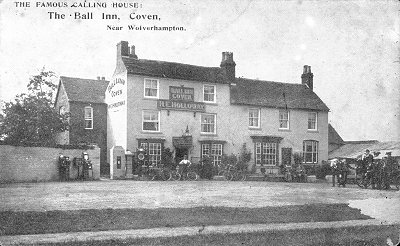
The Ball Inn, Coven Heath. |
Although conditions for the predominantly working class population in the
1920s and 30s were not easy, and there was some unemployment, there was
never the widespread poverty known in other parts of the country. This was
due in the main to the Wolverhampton area not being dependent on any one
particular industry, and by the late 1930s as companies like the Goodyear
Tyre and Rubber Company and Guy Motors expanded production unemployment was
considerably reduced.
|
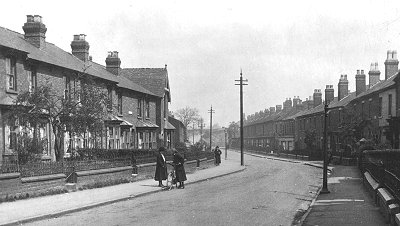
Bushbury Lane, about 1930. |
Older residents
will remember the lady with the bicycle, Deaconess Parker.
The L.N.W. Railway
signal gantry to the left of the bridge was a landmark for several
generations. |
New housing, new transport
| In March 1925 the tram service from Wolverhampton was
replaced by single deck trolley buses to Oxley (later extended to
Fordhouses), and following the raising of the bridge under the GW main line
on Stafford Road in 1936 double deck buses were used.
These served the
people living in the new council houses at Oxley, as well as the ribbon
development' along the Stafford road to Fordhouses. |

Another view of Bushbury Hill in the 1930s. |
 |
| Looking down Oxley Bank (now the
Stafford Road) in Edwardian times. The house on the left is now the
Croft public house. The tram is standing at its terminus.
|
|
By far the greatest change of the 1920s however was the
building of the Low Hill estate of council houses in the parish. 101 acres
of land were purchased from the Showell Estate and a further 232 acres from
the Low Hill Bushbury Estate Company. Low Hill House, and later Showell Farm
were demolished, and by 1927 nearly 2000 houses had been built by various
contractors for Wolverhampton Corporation. A complete new road system was
laid down obliterating the old bridleways which had linked Showell Farm, Low
Hill House, Bushbury Hill Farm and Oldfallings. |
| Most of the new residents came from other parts of
Wolverhampton and were employed outside the parish. New bus services were
started, double deck trolley buses ran from Stafford Street down Cannock
Road to Park lane, First Avenue, Showell Circus and Bushbury Hill.
A service
of motor buses also ran from the junction of Tenth and Sixteenth avenues via
Bushbury Lane, Stafford Road, Gorsebrook Road and Chapel Ash to the
`Fighting Cocks' on Sedgley Road. |
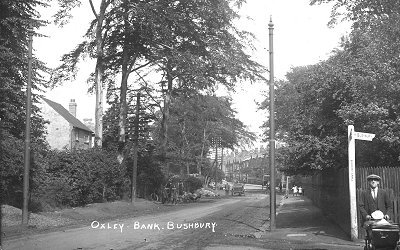 |
| A slightly later view of Oxley Bank, from an old
postcard. Bushbury Lane runs off to the right. |
|
|
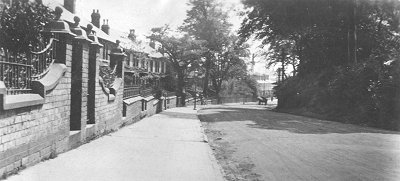
Oxley Bank again from another old postcard. |
More council houses were built in the 1930s, between
Bushbury Lane and Fordhouse Road and in Three Tuns Lane, and several hundred
houses were built by private developers in the Elston Hall and Marsh Lane
areas.
A branch library was established in Showell Circus in 1932,
followed by the Community Hall nearby in 1937.
|
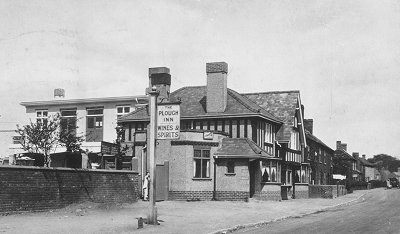
The Plough Inn, from an old postcard.
New parishes, new churches
By the early 1920s the population of the parish had grown to
such an extent that the old ecclesiastical parish of 'Bushbury with
Essington' was far too large, and it was therefore divided. A new church of
St. John the Evangelist was built at Essington and consecrated in 1933. St.
Aidan's Mission Room at Newtown had been opened in 1931.
Also in Bushbury parish itself, new church accommodation was
urgently needed for the ever expanding population. In 1929 the Mission of
the Good Shepherd was built in Second Avenue in Low Hill. A timber framed
building clad with asbestos, it did sterling service both as church and
mission room for social occasions until it was destroyed by fire in 1946.
In 1932 the Church of the Epiphany was built on Stafford
Road at Oxley, and another separate parish established out of the area
served by the mother church.
The Second World War
The first direct impact of the Second World War in the
parish was the arrival at the end of May 1940 of trainloads of exhausted men
from Dunkirk. The green Southern Railway coaches travelled up from the G.W.
Junction at Cannock road, and as they waited for the London Midland engine
from Bushbury sheds, the people from the Showell Road area brought jugs of
tea and sandwiches, until the trains moved on to the north.
The parish was fortunate, like most of Wolverhampton, to
escape heavy bombing, unlike Birmingham and Coventry. Late in 1941 a single
German aircraft dropped some two kilogramme incendiary bombs on the council
houses between Bushbury Hill and the `Pear Tree'; the empty `stick' fell in
Elston Hall lane. There was some damage but no casualties.
|
A much more spectacular conflagration had taken place on the
11th and 12th of March in the same year at the Britool factory in Fourth Avenue. A warehouse there was
being used to store bales of crude rubber and sacks of carbon black for the
Goodyear Tyre and Rubber Company, and about 7 p.m.. one evening a fire
started which soon developed into a serious threat to the whole factory.
Fire pumps were called in from other areas and by midnight about one hundred
men were fighting the blaze. Water which was pumped up from Bushbury Pool ran back
carrying liquid rubber and carbon black, a horrible mixture which had dire
effects on the fish stocks. It was daybreak before the blaze was brought
under control. |
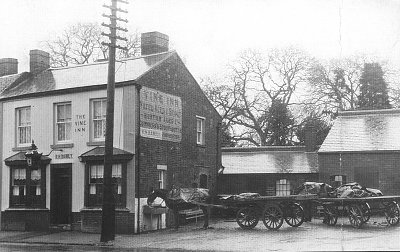
The Vine Inn,
Fordhouses. The licensee, when this photograph was taken in 1916,
was R. H. Danily. |

Fordhouses, from an old postcard,
looking north from The Vine. The houses on the left were demolished for
the dual carriageway c.1937.
|
In the fields to the north of Moseley Old Hall a new
armaments factory started production in 1942, manufacturing armour piercing
shells. The tungsten carbide heads were produced in one part, run by Hard
Metal Tools Ltd. of Coventry, and the explosive and propellants filled in
another run by the Royal Ordnance Department.
To serve the factory a new
road was cut from the Old Stafford Road at Cross Green to the Cannock Road
at Featherstone. The development also included a hostel for employees at
"Brinsford Lodge". |
| The Scotlands, Cannock Road, from an
old postcard, looking towards the "Pear Tree", about 1930.
On the left
is Primrose Lane; on the right is Blackhalve Lane.
The wires for the
trolley bus service can just be seen; the service terminated at the
"Pear Tree". |
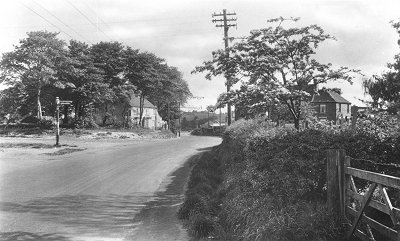 |
After the war
There were the usual celebrations and street parties at the
end of the war. Slowly the surviving servicemen began to come home. More new
houses were built:, and the parish, now with a population several hundred
times larger than that of 1550, took its place in the "consumer society"
which was to develop in the second half of the twentieth century.
 |
|
 |
|
 |
Return to the
19th century |
|
Return to
the contents |
|
Proceed to
Bushbury Church |
|


















